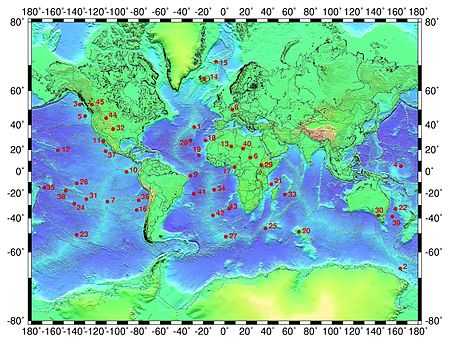Azores hotspot

The Azores hotspot is a volcanic hotspot located at the Azores in the Northern Atlantic Ocean. A volcanic hotspot is defined as an area of high volcanic activity, a long term source of volcanism. The type of hotspot that characterises the Azores is a relatively young one associated with a bathymetric swell, a gravity anomaly and basalt geochemistry that differs from normal ocean ridge basalts.[1] The Azores hotspot also differs to usual hotspots like Hawaii due the fact that it has interactions with the Mid-Atlantic Ridge which lies just west of the hotspot. The centre of the hotspot plume has been suggested to be located 100 to 200 km east of the Mid-Atlantic Ridge near the island of Faial.[2]
Geological area
The Azores domain comprises the Azores plateau and the Azores archipelago (formed of 9 islands extending a distance of 480 km) which has been volcanically active for around 7Myr. The archipelago lies on the lateral branch of the Mid-Atlantic Ridge near the junction of three major tectonic plates; the North American Plate, the Eurasian Plate and the African Plate.[3] This unique location causes the area to have ridge-hotspot interaction with a variation of volcanic processes.
The Azores Plateau
The Azores archipelago rises from Azores plateau, which is an area of thickened oceanic crust and is thought to be formed from the Azores hotspot 20 Mya. This has been shown through mapping negative velocity S-wave anomalies beneath the Azores. This has shown that beneath the Azores plateau there is a negative anomaly limited in the upper 250–300 km which is suggestive to be a signature to a present day dying plume which would have created the Azores plateau.[3]
Hotspot-Ridge interactions
The Mid Atlantic Ridge offers a different perspective and insight into hotspots. The ridge acts as a cross section through the mantle plume. Anomalies on the Mid Atlantic Ridge have been shown to relate to interactions with the hotspot beneath the Azores. Gravity field modelling studies have shown that the crustal thickness in this area is 60% greater than normal, there is an elevated spreading ridge.[4] The influence of the hotspot on the spreading ridge is mainly asymmetrical to the hotspot (north and south). It is thought that crust at ridges is formed by a combination of processes (magmatic and tectonic) with magma addition coming from short lived magma chambers.[5] The hotspot is suggested to be responsible of increased melt production within the mantle supporting a longer lived magma chamber causing the crust to be thicker. However, the Mid Atlantic Ridge has also been shown to have effects on the Azores hotspot that effected the characteristics of the Azores plateau. It has been suggested that the main volcanic ridges on the plateau were created at the Mid Atlantic Ridge spreading axis. The interactions between the Mid Atlantic Ridge and the Azores hotspot are responsible for the unique geomorphological characteristics displayed in the Azores plateau, archipelago and the area of ridge that passes through it.
References
- ↑ Gente P., Dyment J., Maia M. & Goslin J. (2003). "Interaction between the Mid-Atlantic Ridge and the Azores hot spot during the last 85 Myr: Emplacement and rifting of the hot spot-derived plateaus". Geochemistry Geophysics Geosystems 4 (10): 1–23. doi:10.1029/2003GC000527.
- ↑ Cannat, M., Briais, A., Deplus, C., Escartin, J., Georgen, J., Lin, J., Mercouriev, S., Meyzen, C., Muller, M., Pouliquen, G., Rabain, A. & da Silva, P. (1999). "Mid-Atlantic Ridge–Azores hotspot interactions: along-axis migration of a hotspot-derived event of enhanced magmatism 10 to 4 Ma ago". Earth and Planetary Science Letters 173 (3): 257–269. doi:10.1016/S0012-821X(99)00234-4.
- ↑ 3.0 3.1 Silveria, G., Stutzmann, E., Davaille, A., Montagner, J., Mendes-Victor, L. & Sebai, A. (2006). "Azores hotspot signature in the upper mantle". Journal of Volcanology and Geothermal Research 156 (1-2): 23–34. doi:10.1016/j.jvolgeores.2006.03.022.
- ↑ Bourdon, B., Langmuir, C. H. & Zinder, A. (1996). "Ridge-hotspot interaction along the Mid-Atlantic Ridge between 37°30′ and 40°30′N: the UTh disequilibrium evidence". Earth and Planetary Science Letters 142: 175–189. doi:10.1016/0012-821x(96)00092-1.
- ↑ Singh, S. C., Crawford, W. C., Carton, H., Seher, T., Combier, V., Cannat, M., Canales, J. P., Dusunur, D., Escartin, J., & Miranda, M. (2006). "Discovery of a magma chamber and faults beneath a Mid-Atlantic Ridge hydrothermal field". Nature 442: 1029–1032. doi:10.1038/nature05105.